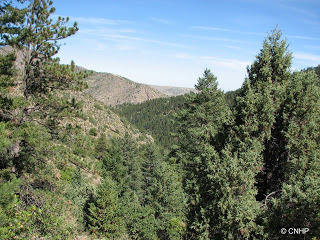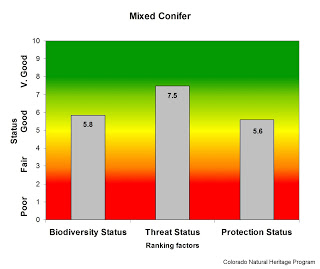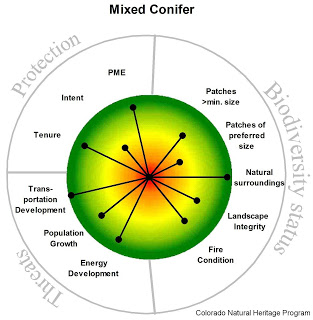800×600
Normal
0
false
false
false
EN-US
X-NONE
X-NONE
MicrosoftInternetExplorer4

These are mixed-conifer forests occurring on all aspects at
elevations ranging from 4,000 to 10,800 feet. Douglas-fir and white fir are the
most common dominant trees, but as many as seven different conifer species may
be present. In many areas of the state these forests form a matrix with large
stands of other forest types such as ponderosa pine or aspen. Natural fire
processes in mixed conifer stands are probably highly variable in both return
interval and severity. Douglas-fir stands are characteristic of drier sites,
often mixed with ponderosa pine. More mesic stands are found in cool ravines
and on north-facing slopes, and are likely to be dominated by white fir with
blue spruce or quaking aspen stands. Fire in these cool, moist stands is
infrequent, and the understory may be quite diverse.
elevations ranging from 4,000 to 10,800 feet. Douglas-fir and white fir are the
most common dominant trees, but as many as seven different conifer species may
be present. In many areas of the state these forests form a matrix with large
stands of other forest types such as ponderosa pine or aspen. Natural fire
processes in mixed conifer stands are probably highly variable in both return
interval and severity. Douglas-fir stands are characteristic of drier sites,
often mixed with ponderosa pine. More mesic stands are found in cool ravines
and on north-facing slopes, and are likely to be dominated by white fir with
blue spruce or quaking aspen stands. Fire in these cool, moist stands is
infrequent, and the understory may be quite diverse.
A number of common and rarer
bird species may be found in these forests, including the white-crowned
sparrow, mountain bluebird, Clark’s nutcracker, Williamson’s sapsucker, and
red-naped sapsucker.
bird species may be found in these forests, including the white-crowned
sparrow, mountain bluebird, Clark’s nutcracker, Williamson’s sapsucker, and
red-naped sapsucker.
Mixed conifer forests cover
more than 850,000 acres in Colorado. Nearly 70% of this area is federal lands,
primarily those managed by the US Forest Service, but lacking wilderness
designation. A substantial portion (15%) is on private land. Consequently,
these habitats are generally in good condition, with minimal threats, and
reasonable protection. Occurrences in the Front Range are vulnerable to the
impacts of housing development, while those in western Colorado are often adjacent
to active oil and gas development.
more than 850,000 acres in Colorado. Nearly 70% of this area is federal lands,
primarily those managed by the US Forest Service, but lacking wilderness
designation. A substantial portion (15%) is on private land. Consequently,
these habitats are generally in good condition, with minimal threats, and
reasonable protection. Occurrences in the Front Range are vulnerable to the
impacts of housing development, while those in western Colorado are often adjacent
to active oil and gas development.

Overall biodiversity, threat, and protection status scores for mixed conifer forests in Colorado.

A “windrose” graph depicting mixed conifer status for individual scoring factors.




